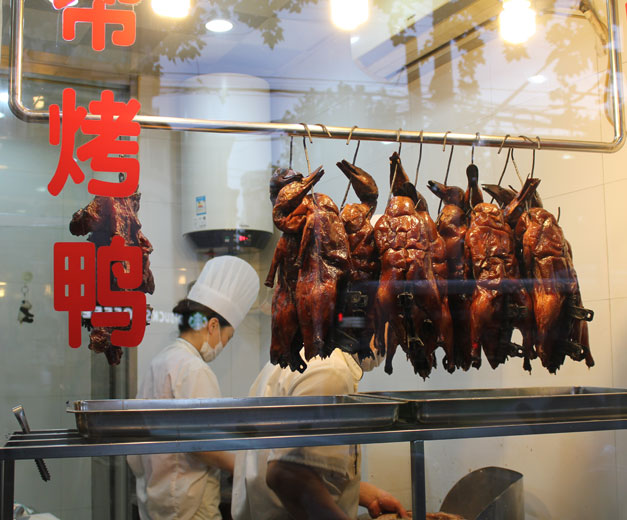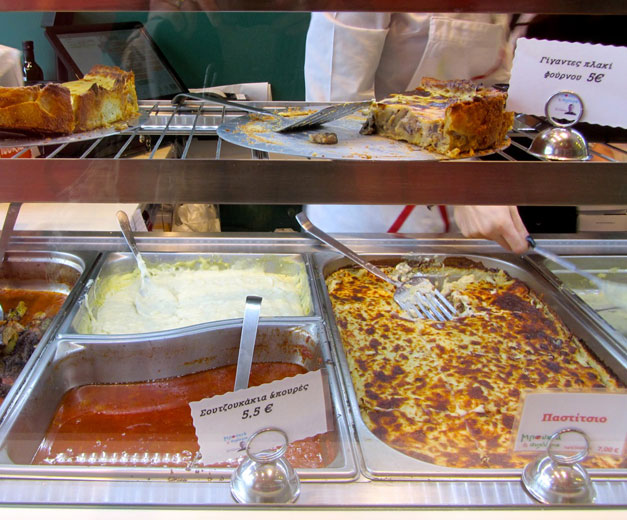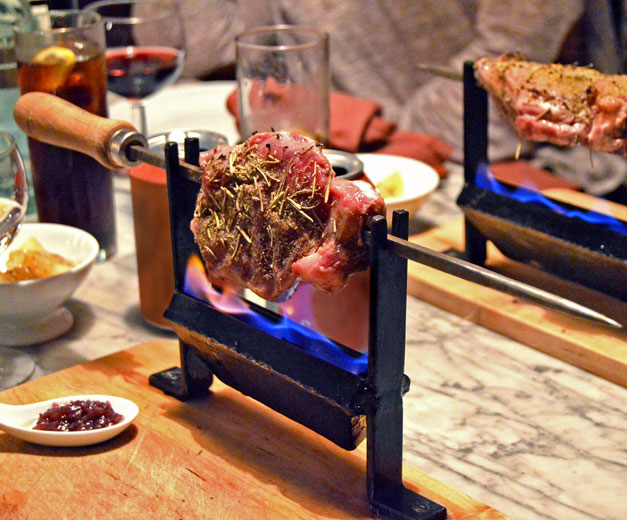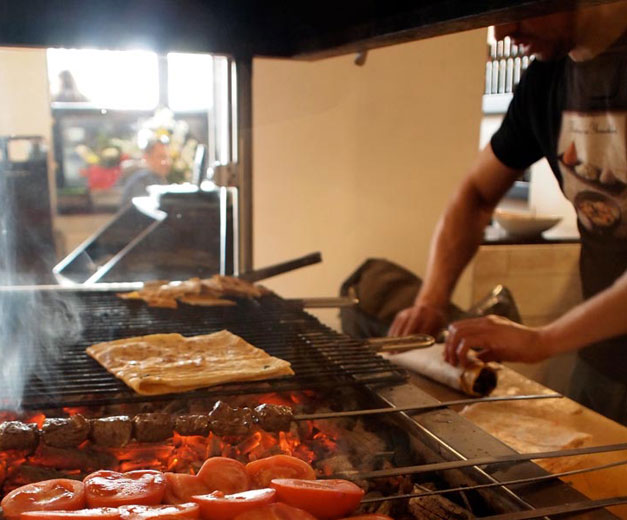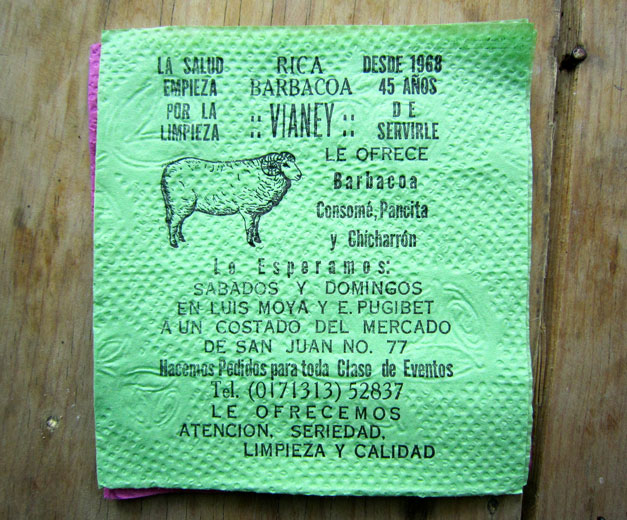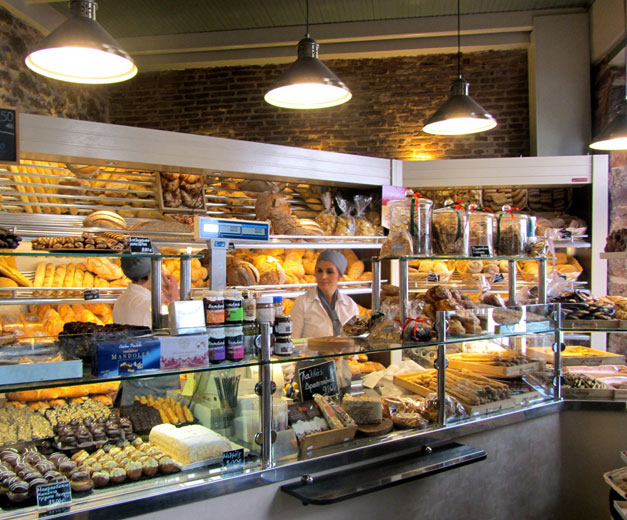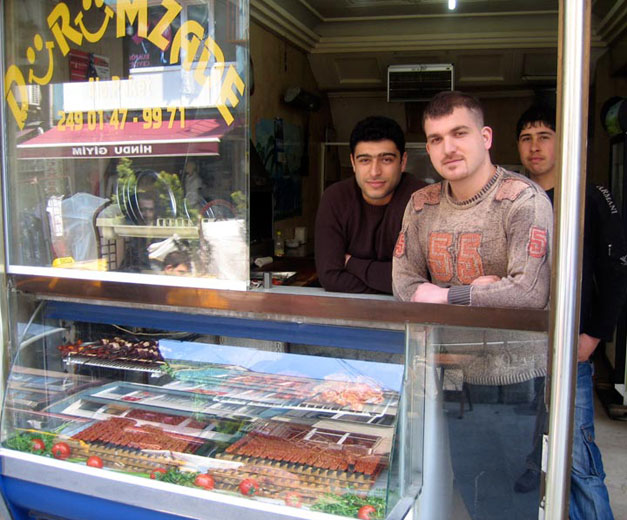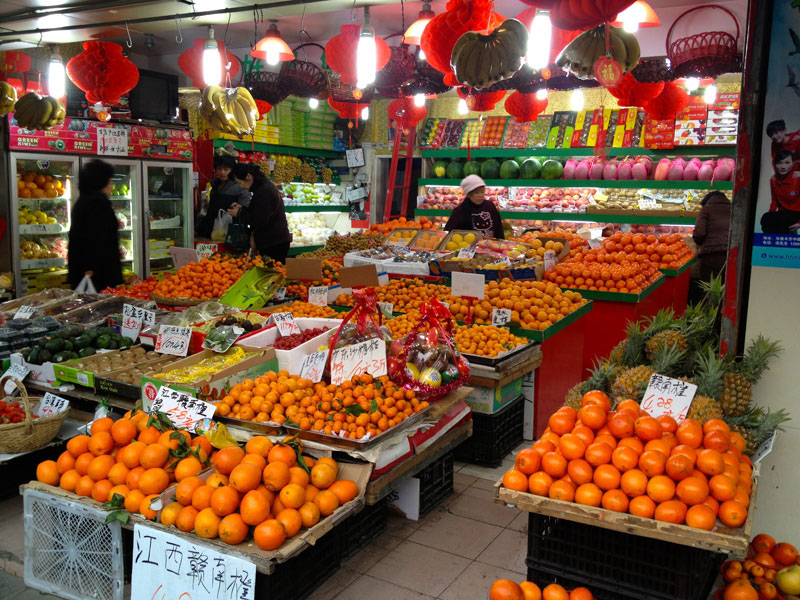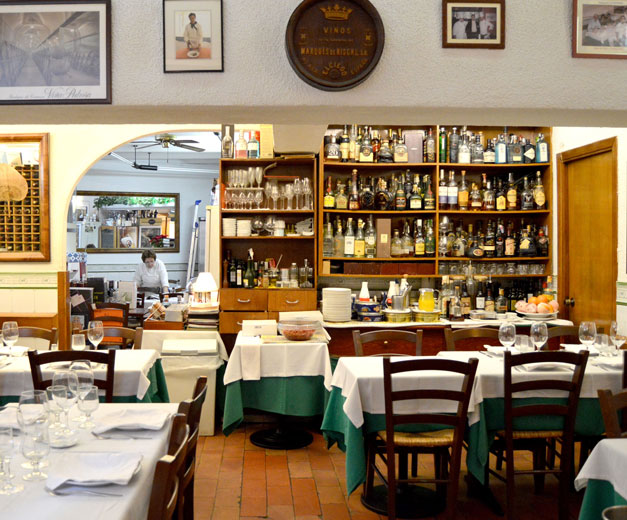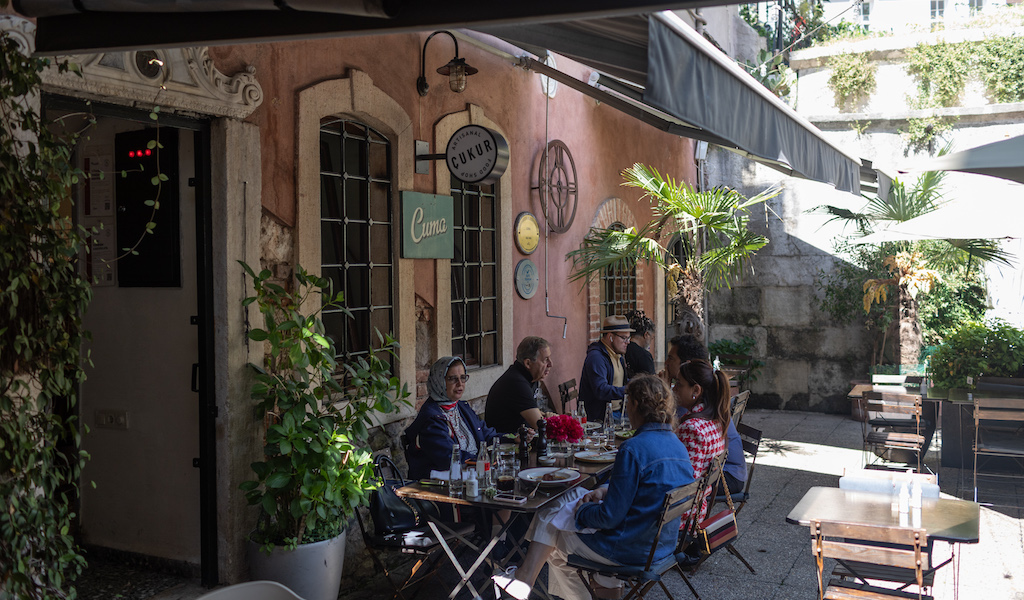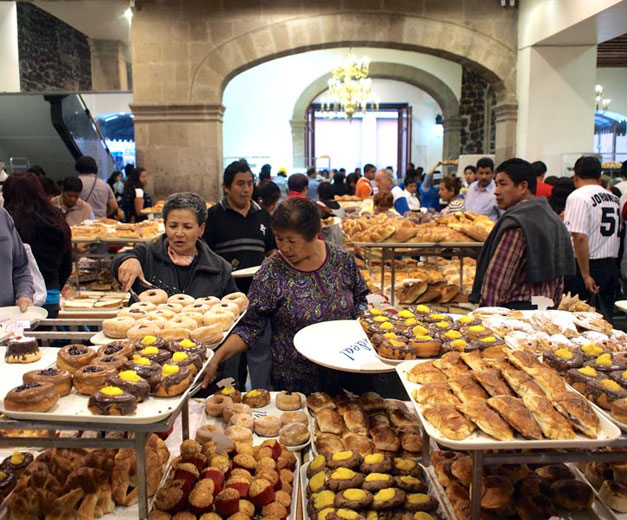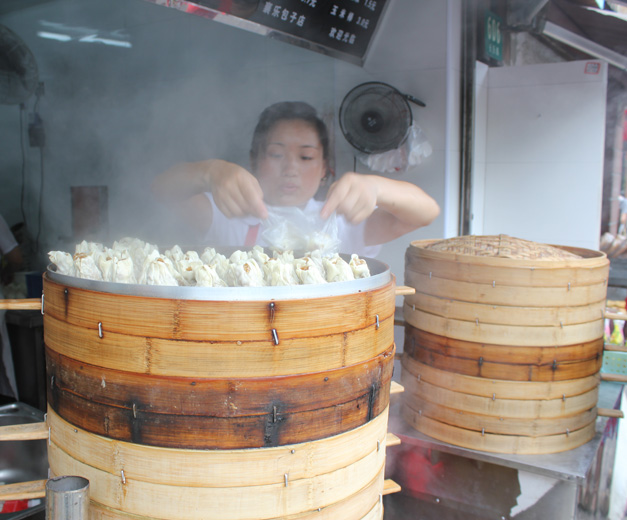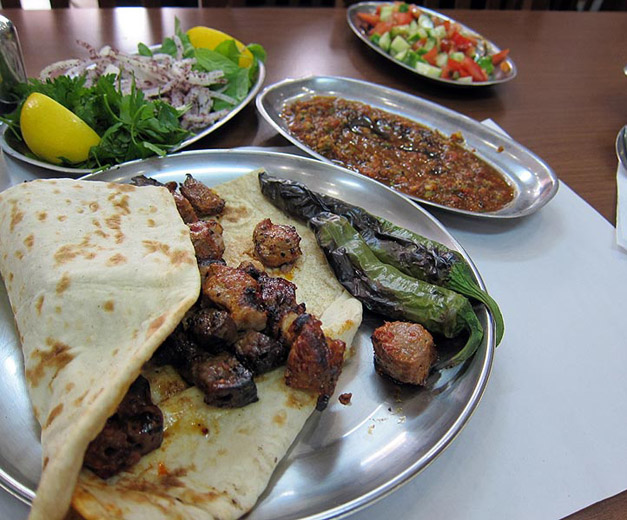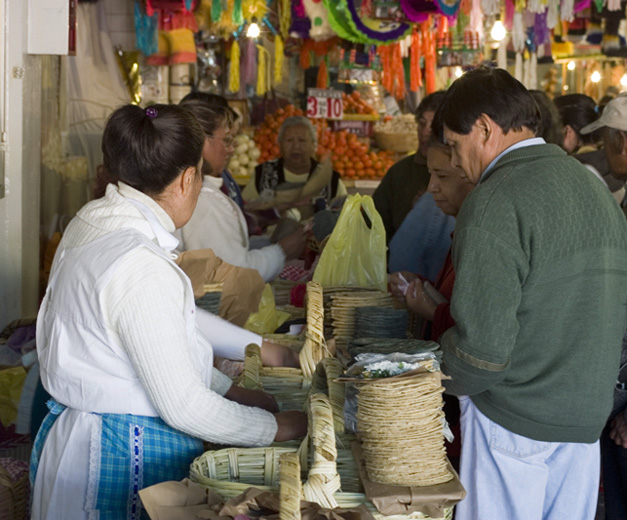We can't find the internet
Attempting to reconnect
Something went wrong!
Hang in there while we get back on track
Search results for
Shanghai
A San Kao Ya: Ducks in a Row
At Culinary Backstreets Shanghai, we’ve already raved about the delicious regional varieties of roast duck – from local Huaiyang birds to the imperial Peking to shāo wèi (烧味), or Cantonese-style. While they each have their own unique breed of deliciousness, we are particular fans of A San’s fusion version.
Read moreRio
Take to the Streets: A Guide to Surviving Carnival in Rio
Carnival in Brazil can be traced back to the 17th century, when the colonial-era population threw street parties, collectively called the entrudo, which involved pelting each other with lemon-scented water. (The governor of Rio de Janeiro tried to ban such raucousness in 1604, but the party lived on.) Throughout the colonial period, Brazil’s lower classes and slaves were the protagonists of street carnival, often imitating the dress and mannerisms of the elite. The entrudo continued, with irreverent (or was it inebriated?) revelers sometimes substituting urine and feces for the scented water in the spirited street parties.
Read moreAthens
Boukia & Syhorio: As Seen on TV
In this time of crisis, the only growth industry in Greece seems to be food. New restaurants, cafés, upscale souvlaki joints, bakeries, shops specializing in traditional products, patisseries, tapas bars, artisanal pizzerias, frozen yogurt, hot dog and crepe stands open every day all over Athens. So it shouldn’t be news when yet another takeaway in the northern suburbs joins them.
Read moreIstanbul
The Salepçi of Sütçüler: The Hard Life of a Sweet Trade
By the name of the place, you’d expect the Sütçüler (“Milkmen” in English) district near Isparta in southern Turkey to be a dairyland paradise, thick on the ground with men carrying buckets sloshing fresh milk, cheese wheels stacked in cool dark sheds, verdant hills freckled with cows. But there are no milkmen in Sütçüler, at least not in the wintertime. The area’s name actually has nothing to do with anything going on in Sütçüler itself.
Read moreMexico City
Mezcalerías: Where There's Smoke
Editor's note: For our last stop on CB's Global Bar Crawl this week, we're pulling up a stool at our favorite mezcal bars in Mexico City, kicking back and savoring every last drop. Para todo mal, mezcal. Para todo bien, también. Y si no tiene remedio, tómate litro y medio. For everything bad, mezcal. For everything good, the same. And if that doesn’t help, drink a liter and a half. – Popular saying among mezcal lovers.
Read moreIstanbul
Barba: Fun House
Editor's note: We're going on a Global Bar Crawl this week, and today we're stopping at a building in Istanbul that has five floors of bars and clubs. Tomorrow we head to Mexico City for some mezcal. We like to think of the building at the corner of Sakız Ağacı Caddesi and Küçük Bayram Sokak as the mullet of the Beyoğlu neighborhood’s entertainment venues – out front is a tidy, little Armenian Catholic church, but in the back, it’s a wild and tangled mess of a party.
Read moreBarcelona
Barcelona's Gintonics: Good to the Last Drop
Editor's note: Our third installment in the Global Bar Crawl takes us to Barcelona, where gin continues to be the drink of choice among locals. Tomorrow we head to a spot in Istanbul where you can spend an evening visiting a number of bars, all without leaving the building. Spain is a country that loves a long-drink – alcohol in combination with a soft drink, refreshing and open to invention and reinvention. On the heels of creative gastronomy’s efflorescence in recent years, many old drinks, cuisines and forgotten ingredients have returned, revived through new and more sophisticated techniques and interpretations. The gin and tonic, called gintonic here, is one such Spanish obsession, and all that ingenuity and focus have gone into taking this highball to the next level.
Read moreAthens
Galaxy and Au Revoir: Booze Cruise
Editor's note: Our second stop on CB's Global Bar Crawl is in Athens, where two classic old watering holes have been tending to the drinking needs of locals for decades. If there’s one realm in which Athens has improved by leaps and bounds since the economic crisis began, it may very well be the city’s bar scene. Perhaps this can be attributed to a sense of nihilism or an uncertain future, but Athens has never had so much to offer in terms of drinking. From theme bars specializing in meatballs and cocktails to boîtes with a different DJ every night to converted bistros in former fabric shops, the list of venues is endless and endlessly varied.
Read moreIstanbul
Zübeyir: The Meat Is On
Finding a kebab restaurant in Istanbul is not hard. There must be thousands of them. But finding the right kind of place, especially if you want to make it a bit more of a meal, can be surprisingly difficult. Most kebab joints tend to be no-frills, in-and-out places. Some are very good (and we will review a few in the future), but they don't make for a night out. On the other hand, some of nicer places – where you can find a more extensive menu and, more importantly, drink booze with your dinner – take things too far. Tuxedoed waiters serving kebab? Griller, please! At the end of the day, we're still talking about meat on a stick cooked over a fire.
Read moreRio
Rio's Food Idioms: It's All Going to End in Pizza
You are what you eat, as the saying goes. Is it any surprise then that food figures so largely in popular culture all over the world? In Rio, food and culture go hand in hand like Romeu and Julieta (for Brazilians, that refers to white cheese and guava paste, respectively, which are such a tasty combination that they are said to be destined to be together). And perhaps nowhere is this more evident than in language – after all, the word for “language” in Portugese, língua, also means “tongue.” In Rio, what the carioca says tells us a great deal about how he eats. To wit:
Read moreBarcelona
Cua Curta: The Veal Deal
Deep in the heart of El Born lies a medieval labyrinth of dark stone buildings and massive wooden doors, scant light, narrow passageways and dozens of colorful little shops, ateliers and hidden bars and restaurants. Of the last, La Cua Curta is one of our favorites, a family restaurant specializing in cheese fondue, unusual salads, carpaccios of meat and fish, homemade pâtés and a remarkable veal steak.
Read moreAthens
Alatsi: Greek Revival
Update: This spot is sadly no longer open. Last summer, we took a look at the popularity of Cretan cuisine in Athens and noted that Alatsi, which introduced the island’s cooking to the city in 2005, had since seen a decline in fortunes. Until now. In early September, Pericles Koskinas took over at the helm and steered the restaurant back on course. The former chef of Milos Athens, Koskinas is famous for his simple and seasonal approach to cooking. He has a talent for bringing out the best in his raw materials with the least possible manipulation and tangling of flavors. Leaving behind a high-end restaurant to resuscitate another whose reputation had tanked was no small undertaking. His first move? He jettisoned the strict Cretan theme, looking beyond the island to all of Greece – and further still. He sources ingredients from small producers, and the majority of them have a protected designation of origin, including wild greens from Messinia, beef and xinotiri (sour cheese) from Naxos, apples from the Taygetos Mountains and eel from Arta.
Read moreIstanbul
Vefa Boza: Strange Brew
Editor's note: In a recent New York Times article, Joshua Hammer wrote about a tour that Nobel Laureate Orhan Pamuk gave him through the author's native city and his personal history there. We were delighted to read that one of Pamuk's favorite places is Vefa Bozacısı, which is one of ours too (and also a stop on the Old City culinary walk). After our first taste, we were not quite ready to sing the praises of boza, a thick, almost pudding-like drink made from fermented millet. But the experience stuck with us. What is that flavor? Something like cross between Russian kvass (a fermented drink made from rye bread) and applesauce may be the best way to describe it. As it did to us, the drink may haunt you, much like the call of the itinerant boza vendors who wander the streets of Istanbul during the winter months calling out a long, mournful “booooo-zahhh.”
Read moreIstanbul
Antiochia: Style and Taste
Editor’s note: Antiochia has moved to a new location. In Istanbul, we’ve noted an inverse relationship between a restaurant’s atmosphere and what’s coming out of the kitchen. In most cases, as furniture design goes slick, as bathrooms get properly lit and ventilated, as the wait staff becomes customer-savvy, the quality of the kitchen inevitably goes down. Presumably, there are those in Istanbul who go out to eat and those who go out to sit in chic restaurants, and never the two shall meet. But just when we thought this theory was watertight, we stumbled upon Antiochia – a small restaurant in Beyoğlu that exudes cool without sacrificing flavor.
Read moreBarcelona
Morro Fi and Mitja Vida: The Whole Vermouth & Nothing but Vermouth
Morro Fi and Mitja Vida are two relatively new entrants to Barcelona’s vermuteo (“vermouthing”) culture, whose history stretches back to the turn of the last century. These two bars are the product of nostalgia for a bygone era fused with the social network- and urban design-driven present. The vermouth tradition in Barcelona was started in the early 20th century by Flaminio Mezzalama, who represented the Italian company Martini & Rossi in Spain, at his fabulous modernist Bar Torino. Vermut began to be produced in Catalonia, and in the following decades, the province developed its own style of the aromatic fortified drink. At the same time, the custom arose of having vermut before lunch with some pickles to whet one’s appetite. That tradition faded over time but has emerged in recent years as a kind of retro, hipster-approved pastime.
Read moreMexico City
Cocina Vianey: Greasy Comfort for the Weekend Warrior
We’ve all been there. One minute you’re in a dive off Garibaldi Plaza watching your out-of-town guests dance with half-naked mariachis, and the next morning, you’re nursing the poor tequila-stricken bastards back to life so they can do it all over again a few hours later.
Read moreIstanbul
Şam Şerif: Culinary Refuge
Editor's note: We're sorry to report that Şam Şerif is now closed. Turkey as a country does not deal in absolutes, even though some of its more bombastic citizens are known to. So when one hears the numerous bewildered complaints about Istanbul’s dearth of falafel and hummus, the correct response is not “Turkish food is not chickpea-compliant,” but “You are not going to the right restaurants.”
Read moreAthens
Ta Alonia: Good Neighbor
Update: This spot is sadly no longer open. The corner shop had stood empty for at least two years, so naturally I was interested when signs of renewed occupancy began appearing just a few blocks from where I live. Plaster came off the façade, revealing beautiful amber-colored stone walls with a cream trim that matched the perforated half-moons above the windows. Then the paper was stripped from the glass, and lo and behold the neighborhood had a new bakery, with tempting displays decorating the sills. Two slender olive trees in wooden churn-like pots planted with red cyclamen guarded the door, but I slipped past them to wish the owners kalo riziko – good roots – and to see what was going on.
Read moreIstanbul
Adana Ocakbaşı: Carnivore Happy Hour
At 6 p.m. on a Monday evening, the dining room of Adana Ocakbaşı was nearly full and the wide grill in the corner was covered with skewers loaded with meat. While most restaurants, worldwide, were closed or waiting for a slow night to start, this neighborhood kebab house was busting through a bumper rush of early birds in for a quick lamb chop or two on the way home. The dinner crowd had not even arrived.
Read moreIstanbul
Dürümzade: Wrap Artists
Istanbul’s after-midnight dining options tend to be of the offal variety – tripe soup, chopped lamb’s intestines – thought to be curatives after a night of hard drinking. Luckily, not all late-night eats in the city involve innards. At Dürümzade – a grill joint positioned right on the fringe of the rowdy, bar-lined streets of the Beyoğlu’s fish market – we’ve found a dürüm, or Turkish wrap, that’s equally satisfying at 2 a.m. or 2 p.m.
Read moreAthens
Bar Bee Kiou: Have It Your Way
Known for its excellent fish and seafood, the port town of Piraeus, just west of Athens, was not until recently a destination for meat lovers. But that all changed a year ago with the opening of Bar Bee Kiou. Situated in the center of town, a two-minute walk from Zea Harbor, this tiny eatery is the ideal place to cap off a promenade around picturesque Pasalimani.
Read moreBarcelona
Ask CB: Vegetarian Eating in Barcelona?
Dear Culinary Backstreets,We are traveling with a group of friends to Barcelona. A few of us are vegetarians, and we all love good food. I know Barcelona is a meat – and particularly pork – lover’s paradise, but can you recommend any vegetarian-friendly restaurants? Is it possible to enjoy tapas and Spanish cuisine without meat or fish?
Read moreShanghai
Auspicious Eating: Ringing in the Year of the Horse
As the moon starts to wane each January, people throughout China frantically snatch up train and bus tickets, eager to start the return journey to their hometown to celebrate the Lunar New Year (春节, chūnjié) with their family. This year, revelers will make an estimated 3.64 billion passenger trips during the festive season, up 200 million from the previous year. One of the major draws for migrant workers heading home is the chance to eat traditional, home-cooked meals.
Read moreMexico City
La Casa de las Enchiladas: Get Sauced
Fried tortillas, stuffed and sauced: enchiladas are simple in concept, but they come in a seemingly endless variety, depending on region and ingredients. The tortillas might be made of corn or wheat flour, and they could be stuffed with all manner of meat or vegetables (or both), but the sauce – or salsa – is really what it all comes down to.
Read moreIstanbul
Gülbi's Cafe: Diaspora Dumplings
“I’m not a missionary, but I am not doing this just to make a profit. People must see that there is mantı outside of Kayseri, there’s Crimean Tatar mantı, as well,” explained Gülben Resuloğlu, in front of her restaurant in the leafy Feneryolu district of Istanbul’s Asian Side.If Martha Stewart were in the mantı (also known as “Turkish ravioli”) business, her place would look just like Gülbi’s – meticulously decorated in pastels, white and floral prints. Everything matched, even the two neatly dressed women who welcomed us: Gülben (the Gülbi in question) and her sister, Leyla. But kept just behind tidy appearances, we discovered, is the pain of being Tatar. We’re convinced that this identity, which was forged in the fire of dispersal and diaspora, made the food taste better.
Read moreBarcelona
La Portería: Hidden Talent
Editor’s note: We regret to report that La Portería has closed. Looks can be deceiving. A case in point: La Portería appears dull at first glance, but venture down the few steps that separate this singular restaurant from the street’s frivolity and you will be rewarded.
Read moreShanghai
Kuta's Kitchen: Big in China
It’s been more than half a century now since The Beatles formed, and their worldwide popularity continues unabated. In Japan especially, the band’s presence and influence were outsized almost from the beginning, and John Lennon’s marriage to Yoko Ono cemented the band’s place in Japanese culture.
Read moreRio
Espírito Santa: The Amazonian Kitchen
In a country the size of Brazil, you’ll have an easier time finding a carioca who’s been to Disney World than to the Amazon region, so cut off is it by vast forests and pricey airfares from the cosmopolitan southeastern cities of São Paulo and Rio. When we visited Manaus and took a days-long boat trip on the Rio Solimões, we introduced ourselves as American, living in Rio. Locals seemed uninterested in asking the usual litany of questions about America but grilled us on Rio, which they had only seen in evening telenovelas.
Read moreIstanbul
Cuma: A New Breakfast Regime
Editor's note: Our last dispatch for Breakfast Week takes us to a charming spot in Beyoğlu, where followers of Istanbul's two competing schools of breakfast can enjoy their morning meals side by side. Istanbul is a dynamic city, where conditions can change so quickly and completely that it’s easy to forget the way things used to be. The new reality can be so strong and ever-present that the past feels like a hazy dream, if that. But no, this is not an article about Turkish politics. This is an article about Turkish breakfast.
Read moreBarcelona
Can Ros: Put a Fork in It
Fried pig’s ears fortified with garlic and parsley, veal cheek and tongue laced with vinaigrette, hefty veal and pork meatballs, creamy artichoke or eggplant omelets or a hearty bocadillo of marinated tuna, red pepper, anchovies and olives: these esmorzars de forquilla, or “fork breakfasts,” are how a Catalonian might start his day – especially at Can Ros, a tapas-and-bocadillos joint that’s open every day from 7 a.m. until midnight. Office workers might drop by for a coffee at mid-morning, followed by the lunch crowd, which takes over from 2 p.m. to 4 p.m. Dinner, of course, lasts well into the night. It’s breakfast, however, that has made Can Ros most popular among locals.
Read moreAthens
Breakfast in Athens: The Morning Report
Editor's note: We are regret to report that Nixon and Hip Cafe are closed. Editor's note: Our third installment for CB's Breakfast Week takes us to Athens, where we take a look at traditional breakfasts and how globalization is changing the way Greeks eat -- especially on weekend mornings. In Athens, brunch has become big business. Over the last couple of years, locals have fully embraced this foreign import, and numerous venues have sprung up across the city to bring Eggs Benedict and Bloody Marys to hungry Athenians every weekend.
Read moreMexico City
Rise and Shine: A Mexico City Breakfast Primer
Editor's note: It's Breakfast Week at CB, and the second piece in the series takes us to Mexico City for a look at typical morning meals and the best places to find them. Stay tuned for more breakfast dispatches from other CB cities throughout the week. Mexico leads the world in per capita egg consumption, according to the country’s National Poultry Institute. That’s not hard to believe if you’ve ever taken a look at a typical Mexican breakfast; in homes and at restaurants huevos are the first order of the day for many a desayuno. And with all those eggs they eat, Mexicans have come up with a number of ways to dress them up or down. One of the most popular ways to prepare them, for example, is huevos revueltos al gusto, two or three scrambled eggs with an additional ingredient or ingredients, such as ham, chorizo, sausage, vegetables or a la mexicana (onion, chilis and tomato). Huevos can also come divorciados, which are two sunny-side-up eggs, one bathed in green salsa and the other in red; rancheros, or fried and served over corn tortillas and refried beans and bathed in a red or green salsa; al albañil, scrambled and served with a very hot red salsa and fresh cheese; or ahogados, poached in green or red salsa. Most of these egg dishes are served with a side of refried beans, avocado and corn tortillas.
Read moreShanghai
Step Away from the Buffet: A Shanghai Breakfast Primer
Editor's note: It's Breakfast Week here at CB, and to kick off the series, we first head to a street corner in the heart of Shanghai that offers a remarkable variety of breakfast foods. Stay tuned all this week for more morning dispatches from other CB cities. We’re all guilty of indulging in the complimentary hotel breakfast buffet a little too often while traveling. But in Shanghai, the widest array of street food is on full display in the morning hours, as young professionals and retirees alike gather at their favorite stands for a quick bite with friends or on their way to work.
Read moreRio
Casa Paladino Comestíveis: Preservation Society
In a city filled with Technicolor snack bars, Casa Paladino Comestíveis instead looks more like the kind of place where you’d find seedy men smoking cigars in a black-and-white film. Glass cases lining the walls display manila-labeled cachaça and Cuban rum bottles, with an occasional anachronism, like boxed Toddynho chocolate milk, breaking its turn-of-the-century salon aesthetic. Cloudy mirrors, a handwritten menu and a grape-adorned Bacchus sculpture decorate its black carved wooden walls.
Read moreAthens
Magemenos Avlos: Mad Men in Athens
Just a stone’s throw from centrally located Vasileos Konstantinou Avenue, the tree-lined neighborhood in and around Plateia Proskopon (Scouts’ Square) is verdant and full of charm. Wonderful dining options abound here, with new entrants such as the popular Mavro Provato joining a host of beloved older eateries. Among the latter is Magemenos Avlos, a glamorous throwback specializing since 1961 in European cooking, and a favorite meeting place of musicians, poets, actors, politicians and remarkable personalities of the 1960s and ’70s.
Read moreIstanbul
Babo'nun Yeri: Organ Music
Near the Aksaray metro station, set back from a loveless part of Istanbul crossed by wide roads and overpasses, the kebab is flourishing. Over the past few decades, waves of migration have brought a particularly southeast Anatolian flavor to the otherwise drab apartment blocks and government buildings of this part of the Fatih district. Now bright isot peppers are strung up, handwritten signs in Arabic advertise services in barbershop windows, a nargile café is filled with older men smoking and playing cards. Nowhere else in the city is there such a high density of kebab restaurants and most of them are run by families from the southeastern city of Urfa.
Read moreShanghai
Ask CB: Buying Kitchen Supplies in Shanghai?
Dear Culinary Backstreets, I just moved to Shanghai, and while I’m looking forward to investigating all the street food options, I’d love to be able to make dinner at home too and would like to get into Chinese cooking. Where’s the best place to stock up my new kitchen?
Read moreAthens
Vasilopita: A Sweet Tribute to the New Year
Just after the stroke of midnight on New Year’s Eve or on the first day of the New Year, many Greek Orthodox families gather around the table to cut and split the vasilopita, a cake named after St. Basil (Aghios Vasilios), the Greek Santa Claus. The head of the family “crucifies” the cake three times with a knife and then cuts it into triangular pieces. Usually, the first piece is offered to Christ, the second to the Virgin Mary, the third to St. Basil and the fourth to the “house” before family members and friends each receive one. Some may offer a slice to St. Nicholas, the patron of sailors, to the poor, as St. Basil cared for them, or to the family shop or company. The custom of dividing the vasilopita is performed at many events throughout January and even into early February among many associations, agencies and other organizations. Each person wishes the others chronia polla (“many years”) and “Happy New Year” to bless the house and to bring good luck.
Read moreShanghai
Lao Beijing Shuan Guo: Hotpot Hotspot
The hotpot’s storied history stretches back over a millennium in China. The cooking method originated in Mongolia, where legend has it that warriors used their helmets as makeshift pots, boiling strips of horse and lamb meat over campfires to sustain them as they made their way south to breach the Great Wall. As hotpot cooking proliferated, regional variations took their toll on the meal’s simplicity, earning it the nickname of “Chinese fondue” among some Westerners.
Read moreMexico City
Mercado Xochimilco: Get Off the Boat
One of our favorite places in Mexico City is Xochimilco. Like many visitors, when we hear the word “Xochimilco” the first thing that comes to our mind is a relaxing ride aboard a trajinera, or boat, on the waterways of this southern borough. We’ve been to Xochimilco many times before, on family excursions to buy flowers, plants and compost from the local farmers.
Read moreBarcelona
El Passadís del Pep: Simple Pleasures
A hidden culinary sanctuary, El Passadís del Pep may be located in one of the most visited quarters of Barcelona, but it’s out of sight of anyone who isn’t looking for it. Once you go down the long corridor that leads to the restaurant, you don’t need to do anything, and that includes choosing what to eat. From the moment you sit down, the “house” offers you your first bottle of cava, and the celebration of food and life begins. There is no menu and there are no “daily specials,” just whatever Joan Manubens and his team decide to cook that day.
Read moreIstanbul
Best Bites of 2013: Istanbul
Editor’s note: This is the final installment of “Best Bites of 2013,” a roundup of our top culinary experiences over the last year. Be sure to check out the "best bites" in all the other cities CB covers. Breakfast in Erzincan We were strangers in a strange land – eastern Turkey’s Erzincan, to be exact – and Yalçın Kaya welcomed us into his cheese shop with such gracious fervor that it didn’t surprise us to find out that this Anatolian cheesemonger moonlights as an imam.
Read moreAthens
Best Bites of 2013: Athens
Editor’s note: This post is the penultimate installment of “Best Bites of 2013,” a roundup of our top culinary experiences over the last year. Be sure to check out the “Best Bites” from all of the cities Culinary Backstreets covers. To Rodi Tucked into a small corner of a working-class residential suburb, with unimpressive décor reminiscent of a local souvlaki joint, the Armenian-Turkish restaurant To Rodi is further evidence that appearances can be deceiving.
Read moreMexico City
Best Bites of 2013: Mexico City
Editor’s note: This post is the fourth installment of “Best Bites of 2013,” a roundup of our top culinary experiences over the last year. Stay tuned for “Best Bites” from all of the cities Culinary Backstreets covers. Hilaria Gastrobar We visited this restaurant on revitalized Madero Street downtown just a few months after it opened, and we were immediately won over by the food and beer selection.
Read moreRio
Best Bites of 2013: Rio
Editor’s note: This post is the third installment of “Best Bites of 2013,” a roundup of our top culinary experiences over the last year. Stay tuned for “Best Bites” from all of the cities Culinary Backstreets covers. Bar do Adão There are so many good fillings – 65, in fact – for the pastéis, or fried turnovers, at Bar do Adão that we appreciate their diminutive size, which allows us to eat a greater variety in one sitting.
Read moreBarcelona
Best Bites 2013: Barcelona
Editor’s note: This post is the second installment of “Best Bites of 2013,” a roundup of our top culinary experiences over the last year. Stay tuned for “Best Bites” from all of the cities Culinary Backstreets covers. Forn Baluard We started the year off heating our hands near the wood-fired oven at Forn Baluard, one of Barcelona’s top bakeries. It hasn’t been around long, but it has decades of experience in its DNA, as it’s headed up by Anna Bellsolà, a fourth-generation baker.
Read moreShanghai
Best Bites 2013: Shanghai
Editor’s note: This post is the first installment of “Best Bites of 2013,” a roundup of our top culinary experiences over the last year. Stay tuned for “Best Bites” from all of the cities Culinary Backstreets covers. Deng Ji Chuan Cai Culinary bucket lists are some of the best ways to discover our friends’ hidden gems: expat foodies are only willing to give up their proprietary favorites when they’re heading home.
Read moreIstanbul
CB on the Road: In Eastern Turkey's Yogurtlands
Like many other Central Anatolian cities, Erzincan is one of those places with very little there there. The natural setting – on a high plateau and ringed by craggy peaks – is promising, but the town itself feels like it’s been scrubbed clean of all traces of history or local distinctiveness, its streets lined with characterless buildings painted in fading pastels, their ground floors occupied by the same furniture and supermarket chains found in every other city in the Turkish heartland. Erzincan does have one thing going for it, though: it’s the kind of place where you can land at the airport, hop into a waiting taxi and ask your driver to take you to the local cheese sellers’ bazaar, and he’ll take you straight there, no questions asked, as if it’s the most natural request he could get.
Read moreAthens
Culture Clubs: Athens' Top Spots for Greek Yogurt
In a recent New Yorker profile of Turkish entrepreneur Hamdi Ulukaya, founder of Chobani, a wildly successful company that makes Greek-style yogurt in the U.S., we read with great interest about the trip writer Rebecca Mead made to Argos, in the Peloponnese, where renowned cookbook author Diane Kochilas had told Mead she’d had “the best yogurt she had ever tasted.”
Read moreMexico City
La Casona del Sabor: School Lunch
Once considered Mexico City’s next hot neighborhood, Santa María la Ribera, near the city's center and one of its first suburbs, has been slow to deliver on that promise. While neighborhoods just to the south have stolen Santa María’s thunder, it’s finally showing signs of life – one of which is the restaurant/cooking school La Casona del Sabor. Built 140 years ago by a German immigrant couple, the building that houses La Casona features traditional colonial architecture, including a grand entrance that leads into a spacious, landscaped courtyard. Looking out over the courtyard is a colorfully tiled verandah that connects to multiple rooms. Once family quarters, these rooms now serve the culinary school. The school's head chef, Jorge Luiz Alvarez, began the school seven years ago in his nearby apartment, but when space became tight, he took over the house and expanded the business.
Read more